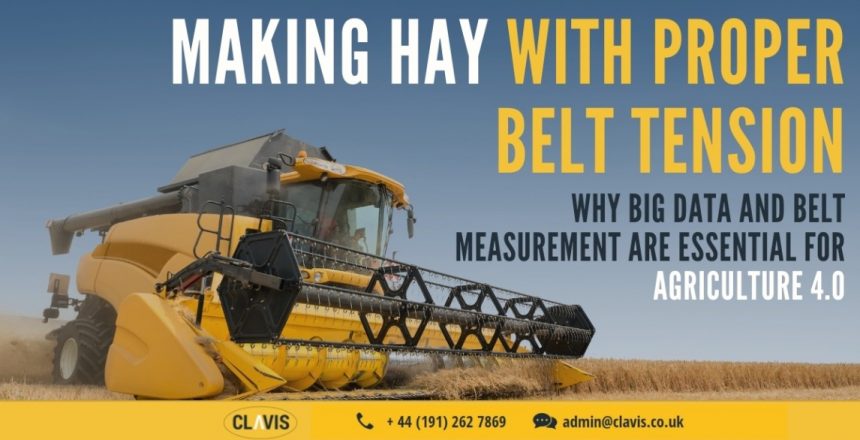Industry 4.0 and automation are becoming essential to agriculture. But this equipment is increasingly expensive, with complex moving parts, electrics, hydraulics and sensors that make breakdowns highly expensive. And what’s the biggest cause of equipment breakdowns? Worn belts. In my latest blog, I explain why Clavis’s belt measurement systems can help farms properly embrace what many are calling “Agriculture 4.0”.
Agriculture 4.0 is the next anticipated big trend in farming, promising a bigger focus on precision agriculture using the Internet of Things (IoT) and big data. It’s hoped these systems will help address the challenges of rising populations and climate change. Indeed, the World Government Summit’s recent Agriculture 4.0 – The Future Of Farming Technology report expects that global farming will need to be able to produce 70 per cent more food to satisfy demand by 2050, while the UN’s Food and Agriculture Organisation also predicts new technologies will play a crucial role if conventional agriculture is to meet growing demands on the market.
Meanwhile, machinery prices jumped by 80 per cent between 2009 and 2019, according to the UK Office for National Statistics, and mechanisation now represents 25 per cent of overall operating costs in today’s farms. This makes equipment breakdowns an expensive proposition that, unfortunately, is not always budgeted for. It also puts greater responsibility on agricultural original equipment manufacturers (OEMs) to deliver machinery that lasts.
“Equipment breakdowns are an expensive proposition that, unfortunately, is not always budgeted for. It puts greater responsibility on agricultural OEMs to deliver machinery that lasts.”
An obstacle to this is belt wear caused by improper belt tension. Did you know that worn belts are among the main reasons that combines break down? Not enough tension can result in slippage, excess heat, premature belt and pulley wear, while too much tension can also result in breakages. Typically, a force gauge is used to manually measure the force of a belt in a push or pull test. However, these gauges are difficult to use in tight spaces and are not always accurate.
So, operators require a more precise option to ensure the tension in belts is set accurately. One solution lies in big data.
Precise belt inspection
There is a great responsibility on farm equipment OEMs to deliver machinery that’s manufactured, tested and guaranteed to high specifications. As with all land-based engineering products, the agricultural equipment market is also highly competitive — which makes equipment longevity a priority.
Fortunately, big data offers a solution. Take, for instance, one of our customers, which has a new product coming to market later this year and needs to do a belt tensioning process on a toothed belt. The customer’s target frequency for measuring the belt is around 150 Hertz (Hz) — but this could change slightly as the design matures. In other words, the customer needs a belt measurement system that it can tweak if needs be, to 130 or 140 Hz for instance, while maintaining the utmost belt measurement accuracy. To that customer, Clavis recommended using the FourierBMS.
“OEMs can greatly improve their after sales support by regularly assessing how a customer’s belt-driven motor performs in the field — or out on the farm!”
The FourierBMS can measure belt tension vibrations between 10 and 500 Hz with an optical sensor head — you can read more about optical versus acoustic sensor heads, here. It’s fully traceable, so all belt measurement readings can be communicated with and stored in your plant’s PCs through software. Like our customers, above, you can continually tweak the frequency at which you measure the belt.
OEMs can greatly improve their aftersales support by regularly assessing how a customer’s belt-driven motor performs in the field — or out on the farm! Should the belt be tightened or loosened for better, longer performance? The FourierBMS has an internal programmable logic controller (PLC). This means the system can run continuously and field engineers can periodically check the tension of belts as part of a Preventative Maintenance Schedule (PMS).
Longer-lasting equipment
With the FourierBMS, belt tension measurement can be integral to an OEM’s Industry 4.0 setup. The system already makes great contributions in other sectors, such as checking the electric power-assisted steering (EPAS) belt tension for the likes of Hyundai Motor and MANDO, helping them achieve very precise inspection levels. In those cases, reliable inspection equipment is vital to ensure driver safety.
In agriculture, the FourierBMS can not only support safety but also longer performance in costlier Industry 4.0-compatible machinery. This applies to more than just larger machines like combines. Clavis has also received enquiries about smaller machines used on farms, like quad bikes. These customers not only benefit from our belt measurement systems and 30-plus years of experience, but also our bespoke CAD capabilities and extensive aftersales support.
As we embrace Agriculture 4.0 and connectivity grows more vital, expensive equipment failures must be taken care of. It’s crucial that belt measurement systems are a part of this digitalisation initiative, preventing improper belt tension that causes wear. Contact me today for a consultation.
Article by Mark Errington

